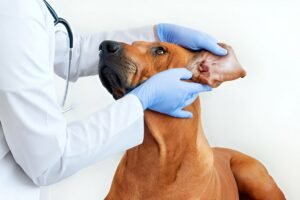There are several things that might cause swelling in your dog’s ears, including dog bites and ear mites.
In order to maintain the health of your dog, Understanding the symptoms of a dogs ear swollen, How to avoid them and what to do when they occur.
Help! Why is my dogs ear swollen? See below for a list of common reasons of dogs ear swollen before you panic.
Recall that dogs have a greater range of frequencies in their hearing and can distinguish considerably more noises from a greater distance.
Causes Of Dogs Ear Swollen
Swelling is one sign of ear problems in dogs. Additional signs and symptoms include walking in circles, strange eye motions, stench, discharge, redness, scabs or crust, head shaking or tilting, and hair loss surrounding the ear.
The most typical reasons for dogs ear swollen include:
Ear Infection

Dogs ear swollen are most commonly caused by ear infections. Swelling is a component of inflammation brought on by infections. Dogs frequently get ear infections, which are usually brought on by yeast or bacteria. Both the inside and outside of your dog’s ears may become infected. The ear canals are the most common location for yeast infections, which may occur more frequently if your dog enjoys swimming. This is because moisture is the perfect habitat for yeast, and water can get stuck in their ears.
Allergies
Like people, dogs can develop allergies, which can result in dogs ear swollen. Your dog’s ears and skin are both susceptible to allergies. The swelling could be coming from an allergic reaction in your dog. An irritation known as an allergic reaction can cause your dog to wag its head and itch at its ears. Your dog may then experience ear swelling as a result of this.
Insect Bite
An alternative kind of allergic reaction that your dog may be suffering from is a reaction to an insect bite or sting. Examine your dog’s ears to see if there are any lumps or bumps there. To prevent inflicting more agony, proceed with extreme caution.
Similar to people, many dogs can get bitten or stung by a bug and recover, but there’s always a possibility your dog could respond badly to it. Keep an eye on your dog’s respiration, heart rate, amount of activity, and degree of swelling in the area of affection. You must take your dog to a veterinarian or emergency veterinarian right away if it is showing symptoms of rapid swelling, irregular heartbeat, difficulty breathing, or a change in general behavior.
Overseas Bodies Or Wax Deformation
There might be anything lodged in your dog’s ear. An accumulation of wax or an alien object may be the source of a dog’s ear enlargement. Swelling may result from the obstruction alone, However, an ear blockage might also result in an infection initially, followed by swelling.
A vet can extract superfluous wax and check to see whether your dog has any other objects stuck in its ear. If anything gets stuck, you might be able to tell straight away, but this isn’t always the case. If a little object got into your dog’s ear, it probably became lodged there past your field of vision. It’s crucial to discuss the likelihood of a foreign body in your dog’s ear with your veterinarian because ear canals extend beyond what is visible.
Ear mites
Though they can affect any dog, regardless of age, mites are microscopic parasites that feed on the wax and oils inside your dog’s ear, causing the majority of ear issues in pups and young dogs.
The waste of the mites, which resemble coffee grounds, can clog your dog’s ear canal in a severe infestation. Ear hematomas, which occur when blood vessels in the ear flap burst due to vigorous scratching and head movement, or severe infections are possible complications.
Your dog may require an insecticidal ear drop, a prescription treatment, or a mild ear cleaning to treat ear mites. Since cats and dogs can contract ear mites, you should treat every creature in your home. As to how long to treat and when to recheck, refer to your veterinarian’s instructions.
Ear hematomas
Another cause of dogs ear swollen. Swollen, hard lumps on the inside of your dog’s ear flap are what these are. They happen when a blood vessel inside the ear flap bursts, causing tissue layers to hemorrhage. Hematomas can also occur from foreign objects lodged in your dog’s ear, which can occasionally be the cause of head shaking or scratching due to ear mites or an infection.
A veterinarian examination is part of the treatment for an ear hematoma to determine the hematoma’s cause. Hemostatomas can be treated medically in many circumstances. To keep the ear flap from reabsorbing blood, it could occasionally be required to drain the blood and perform surgery.
Symptoms Of Dogs Ear Swollen
It is crucial to observe the behavior and physical cues of your dog. Frequently, swelling is accompanied by additional symptoms, like:
- Warmth and redness in the ear area.
- Leakage or unpleasant smell.
- Pawing or clawing at the ear excessively.
- Palpable pain or discomfort when the ear is touched.
- Tilting or shaking the head.
- A Few Quick Tips for Using Ear Medicine
If using ear drops to treat your dog’s ear swelling is necessary, follow these fast steps to make the application process a little easier:
Hold your dog’s head steady while the drips are near. Raise its ear and use a cotton ball and ear solution to clear the wax in the accessible areas. Take caution not to compress wax inside the eardrum or delve too deeply.
Holding onto your dog’s ear, position the ear dropper’s nozzle so that it is inclined in the direction of the nose. Pour in the appropriate amount of drops.
To stop your dog from shaking out the pills, grasp onto their head. Fold your dog’s ear down and massage the base of the ear for 30 seconds to help distribute the drops.
Prevent Ear Issues: Dogs Ear Swollen

Taking Good Care of Your Dog’s Ears Dogs with drooping ears (such as poodles, cocker spaniels, and basset hounds) are particularly susceptible to ear infections, ear mites, and obstructions in their ear canals.
Understanding how your dog’s ears should appear in good condition might help you stop ear issues before they arise. The inside of a healthy ear should be pink, clean, and odorless. Consult your veterinarian right away if your dog’s ears are swollen, red, stinky, or have any form of discharge.
Regular grooming to maintain the health of your dog’s ears entails:
- Veterinary examinations regularly, particularly if your dog has extremely hairy ears or is prone to wax buildup.
- If the inside of the ears is dirty, your veterinarian will advise cleaning with a cotton ball moistened with ear cleaner. Ask your veterinarian for cleaning advice because dog ears are sensitive, and never put anything inside your dog’s ear canal that you cannot see.
- Water can build up within your dog’s ears from frequent bathing or swimming, which can cause an excruciating infection. Place cotton balls in your dog’s ears when bathing them (don’t forget to remove the same amount of balls), and gently dry their ears after playing in the water. Ask your veterinarian if an ear-drying solution would be helpful if your dog is prone to ear infections.
Conclusion
In conclusion, it is critical to pay attention to your dog’s ears if you want to ensure their general health. Responsible pet ownership revolves around routine cleaning, preventative measures, and quick response to swelling. By being aware of the different causes of a dogs ear swollen, You give yourself the ability to give your pet the finest care possible. For a happy life together, keep those ears healthy and those tails wagging.
Remember, a dogs ear swollen doesn’t have to give rise to fear. You can guarantee your pet’s pain-free ear-related existence with information and attention. Should you ever have any questions, “Why is my dogs ear swollen?”Simply go back to this book for advice and ideas to maintain the greatest possible health for your dog!
FAQs
Q: What actions should you take if your dog has a hematoma?
A: The damaged ear of your dog will have a fluid-filled pouch on its ear flap if it has an ear hematoma. If you apply slight pressure on it, it will become relatively firm. Your dog will have pain and discomfort from this, and treatment will be necessary. The hematoma will be examined by a veterinarian, who will also identify the rupture’s primary cause. They must drain and suture the hematoma to treat it. Your veterinarian might recommend a cortisone shot if the hematoma is minor and the swelling is not too severe. In cases where the hematoma is large, surgery may be necessary to maintain the integrity of the ear.
Q: If Your Dog Has An Earsore, How Do You Treat It?
A: Look for any evidence of damage on the exterior of your dog’s ears to perform a preliminary check for an ear infection. An innocent-looking bite wound or other laceration could eventually develop into a dangerous illness. Examine the skin for redness or other discolorations, and look for any bleeding or other fluids in the vicinity of the dog’s external ears. Check for any fresh scents by sniffing the area around your dog’s ears. Even while a dog’s ears might not smell the nicest under normal conditions, an infection could greatly worsen the scent.
Next, look for comparable indications of concern on your dog’s inner ears. Your dog most likely has an infection, which is the reason for the swelling, if there is any obvious damage, redness, coloring, bleeding, discharge, or an unpleasant stench. Your dog has to be examined by your veterinarian if it has an ear infection so they can give an antifungal or antibacterial medication.
